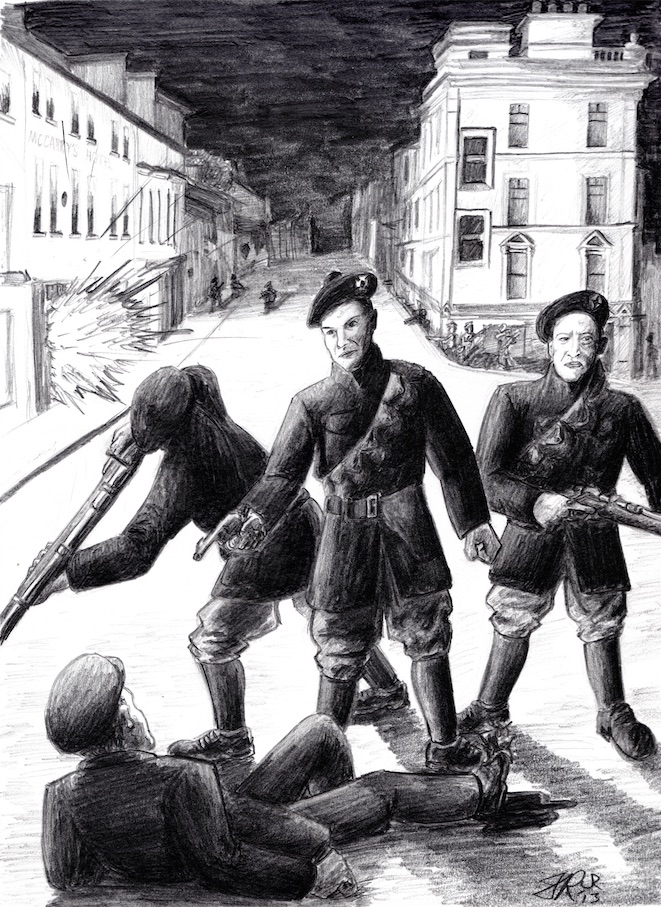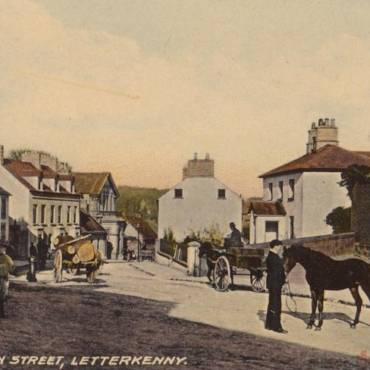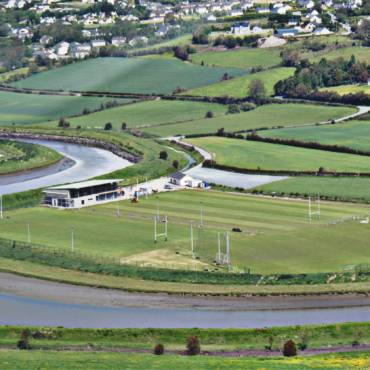The War of Independence in Letterkenny
The first shots of the War of Independence against the British in Ireland are recorded as being fired in January 1919 at Soloheadbeag in County Tipperary. The Irish Volunteers, by now renamed the Irish Republican Army (IRA), targeted Royal Irish Constabulary (RIC) and British Army barracks and ambushed their patrols, capturing arms and forcing the closure of barracks in isolated areas. The British Government responded by importing recruits from Britain—the Black and Tans and Auxiliaries—who became notorious for their ill-discipline and reprisal attacks on civilians in Ireland.
Ernie O’Malley, training officer to the IRA rural units, visited the Letterkenny area in early 1919 to organize the local Volunteers. Up until now, the Irish Volunteers had been generally employed at drill parades, route marches and occasional raids for arms on the homes of Ulster Volunteers, mostly in the predominantly Unionist Laggan area to the east of the town, but from 1919 the organization had a military structure, divided into Divisions, Brigades, Battalions and Companies.
Donegal was now the 1st Northern Division, within which there were four brigades – East Brigade was under the command of Samuel Flaherty from Castlefinn with James Dawson of Castle Street, Letterkenny Vice O/C. Within this Brigade was Letterkenny Battalion (known as 4thBattalion), under the command of Dawson, with four companies, Letterkenny Company (James McMonagle O/C), Manorcunningham Company (William Holmes O/C), Churchill Company (Hugh McHugh O/C) and Fanad Company (Niall Blaney O/C). It was the responsibility of Anthony Dawson, James’ brother, to care for the safe custody of the arms of the unit, which were hidden in a ‘dump’ under the heating chambers of St. Eunan’s Cathedral.
Owing to the presence of both the Army Barracks at Sprackburn and two RIC barracks on the Main Street, incidents during this period were quite isolated in the town of Letterkenny. However, several incidents are worth noting.
In August 1920, under instructions from the Brigade at Castelfinn, ten men from the Letterkenny Company – Dr. J.P. McGinley, James Dawson, Eddie Gallagher, Hugh McGranaghan, Hugh Sweeney, Hugh McGrath, William McLoughlin, and brothers Patrick and James McMonagle – were among a party that carried out a daylight raid on Drumquinn R.I.C. barracks in County Tyrone where a constable was killed and a sergeant was badly injured in the attack. At this time, a District Inspector of the R.I.C. named Patrick Walsh had been recently stationed in Letterkenny. After this raid at Drumquinn, D.I. Walsh called to the surgery of Dr. McGinley and produced a slip of paper, telling the doctor that he had a description of three men from the raid that he knew were in Letterkenny: “You answer the description of one, James Dawson fits in withthe description given of the second man and James McMonagle is the third.” After a short panic by Dr. McGinley, Walsh informed him that he was working with Michael Collins and was therefore going to destroy the document so that nobody else would see it, warning the doctor to be more careful in the future.
Over his years in Letterkenny, D.I. Walsh would help the local Volunteers evade capture on many other occasions, later becoming Assistant Commissioner of the Garda Síochana force following their formation in the new Irish Free State.
In May 1921, Peadar O’Donnell was commanding a flying column in West Donegal and large detachments of British forces from Derry were sent to that area in an attempt to capture them. O’Donnell issued an order to Anthony Dawson, now O/C in the absence of his brother, to carry out an attack on the British forces in Letterkenny in an effort to relieve the pressure on those men in West Donegal. Dawson organised an attack on the Main Street of Letterkenny on Wednesday 18th May against a patrol of three RIC Constables and one Sergeant.
Dawson and his company lay in wait in McGlynn’s walsteads near the Literary Institute (approximately where the Library is today) and opened fire on the patrol shortly after 11pm while at the same time, another group of men fired at the No. 2 Barracks at the bottom of the town (where the Wolfe Tone Bar stands today). Constable Albert Carter, a 19 year old recruit from Kildare, was shot dead by a revolver bullet to the throat while Sergeant Charles Maguire received two wounds in the hip and the calf.
However, the Black and Tans, located in No. 1 Barracks beside theCourthouse, heard the shots and were quick to retaliate on the streets of Letterkenny. Two local civilians, Anthony Coyle and Simon Doherty, were injured in the reprisals while McCarry’s Hotel, location of the Sinn Féin Courts, was shot up and a grenade thrown through the window:
“There were heavy and continuous fusillades, which continued for several hours, and two civilians were wounded by rifle bullets, Anthony Coyle in the wrist and leg, and Simon Doherty in the foot. McCarry’s hotel was injured, the smoke room windows being completely demolished, pictures and mirrors shattered. A large hole was torn in the floor, apparently by a grenade or bomb. There are several bullet marks on the ceiling and walls. Terror prevailed during the night, few people retiring to bed.”
The attack had the desired effect of drawing off the forces from West Donegal who then concentrated on the Letterkenny district in the belief that the Column had moved in that direction. By July of that year, a truce had been agreed between the British and the Irish and Michael Collins and his team of delegates signed the Anglo-Irish Treaty in December creating the Irish Free State and ending British rule in Ireland, at least in 26 counties.
On Tuesday 28th March 1922, both Letterkenny Barracks were vacated by the R.I.C. and handed over to Col. Commandant Glennon, 1st Northern Division I.R.A. at 7 a.m. The old coat of arms was taken down from over the main entrance, and a large tri-colour flag was hoisted through the window. About 80 R.I.C. then left for the railway station and members of the I.R.A., supplied by Letterkenny Company, occupied the barracks.



